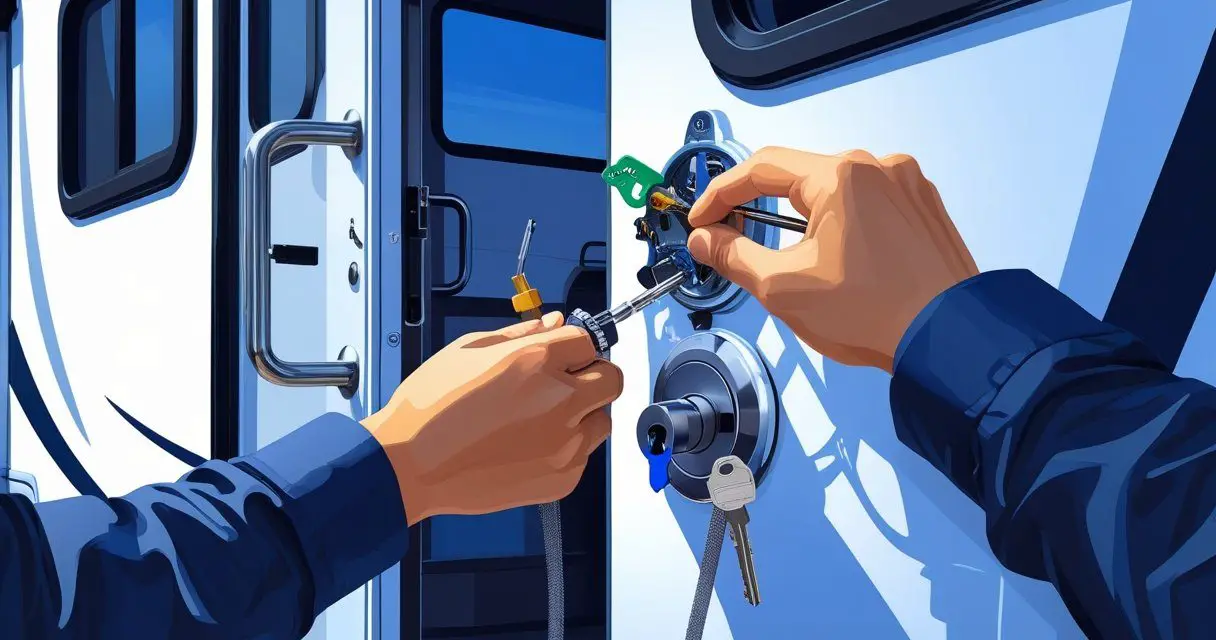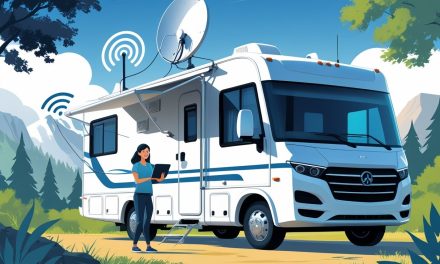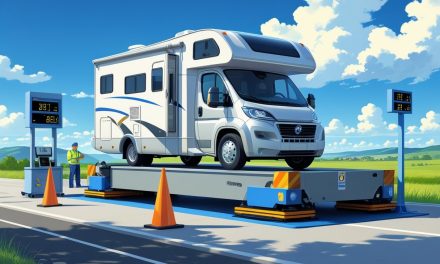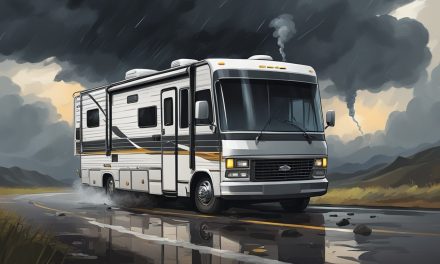Would you like to save this article?
RV security matters, especially when you’re on the road or parked far from home. Lost keys, new ownership, or worn-out locks can make you wonder if changing the locks is your only option.
Yes, you can rekey RV door locks, and in many cases, it’s a straightforward way to keep your RV secure without replacing the entire lock.
Rekeying works by adjusting the pins inside the lock cylinder so the old key no longer works and a new key takes its place. Many RV locks use systems that allow rekeying with the right tools or kits, and some brands even design their locks to make this process easier.
Whether you want all your locks on one key or just need to update security, rekeying gives you flexibility. Understanding how RV locks are built and what options exist can help you decide if rekeying is the right choice.
With a little knowledge, you can save money, improve convenience, and keep control over who has access to your RV.
Key Takeaways
- RV door locks can be rekeyed instead of replaced
- Rekeying involves changing the lock pins to match a new key
- Knowing your lock type helps you choose the best security option
Can RV Door Locks Be Rekeyed?
You can rekey most RV door locks, but the process depends on the type of lock installed and whether you have the right tools. Rekeying lets you change which key works without replacing the entire lock, which can save money and improve security.
What Rekeying Means for RV Door Locks
Rekeying an RV lock means adjusting the lock cylinder so it no longer works with the old key. Instead, it responds to a new key that you set up during the process.
This is done by replacing or rearranging the pins inside the cylinder. You do not need to remove the entire door handle or replace the lock housing.
Instead, you only work with the lock cylinder and the pins. Many RV lock brands sell rekeying kits that include the tools and new keys you need.
If you own your RV, rekeying is legal and safe as long as you follow the instructions for your specific lock. If you are not comfortable doing it yourself, a locksmith or RV service center can handle the job.
Common Types of RV Door Locks
RV door locks vary by manufacturer, but the most common types include TriMark, Global Link, and Bauer. Each brand has its own rekeying system and may require a specific kit or tool.
Many RVs also use cam locks for baggage doors and storage compartments. These locks are often keyed alike with the main entry door, or they can be rekeyed to match a single key for convenience.
Some RV locks, like Global Link models, come with a rekey tool (often a small plastic fob) that makes changing cylinders simple. Others, like older TriMark locks, may require removing the lock cylinder and using replacement pins.
Knowing your lock’s brand and model is important before starting the rekey process.
Benefits of Rekeying RV Locks
Rekeying RV locks improves security by making old keys useless. If you bought a used RV, you cannot know how many copies of the original keys exist, so rekeying ensures only your new keys work.
It also adds convenience. You can rekey multiple locks, such as the main door and baggage compartments, so one key opens everything.
This reduces the need to carry several keys. Rekeying is often cheaper than replacing all locks.
A professional may charge $50–$200 per lock, but DIY kits cost less and can be reused. By rekeying, you extend the life of your existing RV locks while increasing both safety and ease of use.
How to Rekey RV Door Locks
Rekeying an RV door lock means changing the lock pins so the old key no longer works and a new key will operate the lock. This process can make your RV more secure and reduce the number of keys you need to carry.
Step-by-Step Rekeying Process
Start by removing the lock from the RV door. Most RV locks are held in place with 4–6 screws.
Once the lock is free, take out the lock cylinder, which is the part that holds the pins. Insert the old key into the cylinder and turn it slightly.
Use a plug follower tool to push the plug out while keeping the pins and springs in place. If you don’t have the old key, you can still remove the pins, but it may take more effort.
Replace the old lock pins with color-coded lock pins that match the cuts of the new key. A rekey kit usually includes a chart that shows which pins go in which slot.
Use tweezers to handle the small pins and avoid forcing them into place. After installing the new pins, test the cylinder with the new key.
Make sure the key turns smoothly before reassembling the lock and reinstalling it on the door.
Required Tools and Rekey Kits
You will need a rekey kit designed for your specific RV lock brand. These kits often include:
- Plug follower tool
- Color-coded lock pins
- Retainer ring tool
- Tweezers
- New keys
In addition, you may need a small screwdriver and replacement screws. Some RV lock manufacturers sell lock-specific kits, which are easier to use because they match the lock design.
It’s a good idea to purchase a kit ahead of time and keep it in your RV. This way, you’re prepared if you lose a key or need to rekey while traveling.
DIY vs Professional Rekeying
You can rekey your RV locks yourself if you have the right tools and patience. The process is straightforward but requires careful handling of small parts.
A rekey kit makes the job easier and ensures you have the correct pins. If the lock is damaged, or if you’re uncomfortable working with lock cylinders, you may want to hire a locksmith.
A professional can rekey multiple locks quickly and ensure all your RV doors and compartments use the same key. DIY rekeying saves money and gives you control, while professional service offers convenience and reliability.
Understanding RV Lock Components
RV locks use a few key parts that determine how secure the door is and how the key interacts with the mechanism. Two of the most important pieces are the lock cylinder and the lock pins, which work together to control access.
Lock Cylinder and Its Role
The lock cylinder is the main body of the lock where you insert your key. It sits inside the lock housing and contains the moving parts that respond to the key’s cuts.
When you turn the key inside the cylinder, it rotates a plug that either locks or unlocks the latch. The cylinder also holds the pins in place, which must align correctly for the plug to move.
Most RV door locks use pin tumbler cylinders, which are similar to residential locks. This design makes it possible to rekey the lock by changing the pins inside the cylinder without replacing the entire unit.
Because the cylinder is removable, you can access it with a rekeying kit. This allows you to update which key works with the lock while keeping the original hardware in place.
Lock Pins and Their Function
Lock pins are small metal pieces inside the cylinder that control whether the key can turn. Each pin has a specific length, and together they form a pattern that matches the cuts on your key.
When the correct key is inserted, the pins line up at what is called the shear line. This alignment lets the plug rotate freely and operate the locking mechanism.
If the wrong key is used, the pins do not align. The plug stays blocked, preventing the cylinder from turning.
In RV locks, rekeying involves replacing or rearranging these pins to match a new key. A rekey kit usually includes color-coded or sized pins, making it easier for you to install the correct combination inside the cylinder.
Popular RV Lock and Key Systems
RV locks often share common key systems that affect both convenience and security. Some keys are widely used and easy to duplicate, while others offer better protection and flexibility.
Understanding these systems helps you decide whether rekeying or upgrading is the right choice.
CH751 Key and Security Concerns
The CH751 key is one of the most common keys used in RVs, especially for storage compartments and utility doors. Many RVs, regardless of brand, come with locks that use the same 751 key.
This creates a security issue. Because the key is so common, anyone with a CH751 can potentially open your compartments.
It’s convenient if you misplace your key, but it leaves your RV vulnerable. If your RV still relies on 751 keys, you should consider rekeying or replacing those locks.
Some owners replace compartment locks with higher-security cylinders to reduce the risk of unauthorized access. Rekeying can also help if you want to keep the same hardware but change the key pattern.
Master Keys and Keyed-Alike Options
Many RV manufacturers and dealers use master keys. These allow service staff to access multiple RVs with a single key.
While this makes maintenance easier, it also raises concerns about who might have access to your RV. You may also encounter keyed-alike systems, where one key opens several locks on your RV.
For example, the same key might work for the entry door, baggage doors, and storage compartments. This setup reduces the number of keys you need to carry.
If you like the convenience of keyed-alike locks, you can have your RV locks rekeyed to match a single key. However, if you want stronger security, you may prefer to separate certain locks, such as the entry door and storage compartments, so they don’t all rely on one key.
Global Link and Other Notable Brands
Global Link locks are widely used in newer RVs and trailers. These locks are often considered more secure than the CH751 system and are designed to be rekeyed more easily.
A rekey tool, sometimes called a yellow fob, allows you to change the lock cylinders to match a new key. Other brands, such as Trimark and Bauer, also offer RV lock systems with different levels of security.
Some models support electronic or keypad entry, giving you alternatives to traditional keys. If you own a Global Link lock, you can often rekey it yourself with the right kit.
For other brands, you may need a locksmith or replacement cylinders. Choosing the right system depends on whether you want convenience, higher security, or compatibility with existing keys.
Replacing Versus Rekeying RV Locks
RV owners often face the choice of either rekeying existing locks or replacing them entirely. Each option has its own benefits depending on the condition of the lock, your security needs, and your budget.
When to Rekey vs Replace
You should rekey your RV lock when the lock is still in good condition but you want it to work with a new key. This is common if you lose a key, buy a used RV, or want all compartments to match a single key.
Many brands, including RV Locks and More and Bolt Lock, offer rekeying kits that make this process straightforward. Rekeying is also a good choice if you want to avoid the hassle of installing a new lock body.
With a rekey kit, you only change the pins inside the lock cylinder. This keeps the existing hardware in place while giving you a new key system.
You should replace the lock if it is damaged, worn out, or doesn’t provide enough security. Older RVs often use generic keys that many people can open.
In that case, replacing with a higher-security option is safer. Replacement is also better if you want to upgrade to features like deadbolts or electronic locks.
Cost Comparison and Considerations
Rekeying is usually cheaper than replacing. A rekey kit from RV Locks and More can cost between $10–$30, while a professional locksmith may charge $50–$200 depending on the lock type and service call.
Replacing locks is more expensive but may be worth it for added security. Entry door lock replacements often range from $40–$100 per lock, while premium locks or smart systems cost more.
If you replace multiple compartment locks, costs can add up quickly. If you only need a new key, rekeying is practical.
If you want stronger protection or the current lock is failing, replacement is the better long-term investment.
Specialty and Compartment Locks in RVs
Not all RV locks serve the same purpose. Entry doors, storage compartments, and specialty areas often use different lock types, each with its own security level and options for rekeying or replacement.
Cam Locks and Storage Compartments
Most exterior storage compartments on RVs use cam locks, which are small, simple mechanisms designed more for convenience than high security. These locks are often keyed alike across many RVs, meaning another RV owner with a similar key could open your storage doors.
Because of this, cam locks are considered a weak point. A screwdriver or similar tool can sometimes force them open, making them less reliable for protecting valuable items.
If you use your compartments for tools or expensive gear, you may want to replace or upgrade them. Rekeying cam locks is possible but not always practical.
Many are standardized, so replacing them with a stronger lock or a unique key set is usually the better option. Replacement cam locks are inexpensive and widely available, often sold in packs so you can match all compartments to a single key.
When choosing replacements, look for slam latch locks or upgraded cam locks with more durable construction. These options increase resistance to tampering and give you better control over who has access to your storage spaces.
Upgrading to Advanced Lock Systems
Beyond basic cam locks, you can install advanced lock systems on both entry doors and compartments. Options include electronic keypad locks, keyless entry systems, and even fingerprint-enabled locks.
These provide more convenience and higher security than standard mechanical locks. An electronic lock allows you to set unique codes, eliminating the need to carry multiple keys.
Some models also include backup keys or fobs in case the battery dies. This reduces the risk of lockouts while still maintaining strong security.
Upgrading to advanced locks can also help you manage multiple access points. Instead of juggling different keys for doors and compartments, you can standardize access with one system.
While these upgrades cost more than standard cam locks, they offer greater protection and peace of mind for your RV.






